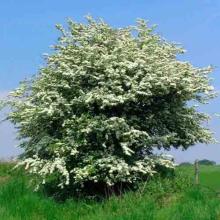Crataegus monogyna
Common name:
Common hawthorn
Genus:
Crataegus
Family:
Rosaceae
Order:
Rosales
Crataegus monogyna
Common name:
Common hawthorn
Genus:
Crataegus
Family:
Rosaceae
Order:
Rosales
Crataegus monogyna
Common name:
Common hawthorn
Genus:
Crataegus
Family:
Rosaceae
Order:
Rosales
Genus (Plantae): Crataegus
Crataegus (/krəˈtiːɡəs/), commonly called hawthorn, quickthorn, thornapple, May-tree, whitethorn, Mayflower or hawberry, is a genus of several hundred species of shrubs and trees in the family Rosaceae, native to temperate regions of the Northern Hemisphere in Europe, Asia, North Africa and North America. The name "hawthorn" was originally applied to the species native to northern Europe, especially the common hawthorn C. monogyna, and the unmodified name is often so used in Britain and Ireland. The name is now also applied to the entire genus and to the related Asian genus Rhaphiolepis.
Etymology
The generic epithet, Crataegus, is derived from the Greek kratos "strength" because of the great strength of the wood and akis "sharp", referring to the thorns of some species. The name haw, originally an Old English term for hedge (from the Anglo-Saxon term haguthorn, "a fence with thorns"), also applies to the fruit.
Description
Crataegus species are shrubs or small trees, mostly growing to 5–15 m (15–50 ft) tall, with small pome fruit and (usually) thorny branches. The most common type of bark is smooth grey in young individuals, developing shallow longitudinal fissures with narrow ridges in older trees. The thorns are small sharp-tipped branches that arise either from other branches or from the trunk, and are typically 1–3 cm (1⁄2–1 in) long (recorded as up to 11.5 cm or 4+1⁄2 in in one case[9]). The leaves grow spirally arranged on long shoots, and in clusters on spur shoots on the branches or twigs. The leaves of most species have lobed or serrated margins and are somewhat variable in shape. The fruit, sometimes known as a "haw", is berry-like but structurally a pome containing from one to five pyrenes that resemble the "stones" of plums, peaches, etc., which are drupaceous fruit in the same subfamily.
Taxonomy
The number of species in the genus depends on taxonomic interpretation. Some botanists in the past recognized 1000 or more species, many of which are apomictic microspecies. A reasonable number is estimated to be 200 species. The genus likely first appeared in the Eocene, with the ancestral area likely being Eastern North America and in Europe, which at that time remained closely linked due to the North Atlantic Land Bridge. The earliest known leaves of the genus from the Eocene of North America, with the earliest leaves from Europe being from the Oligocene.
Ecology
Hawthorns provide food and shelter for many species of birds and mammals, and the flowers are important for many nectar-feeding insects. Hawthorns are also used as food plants by the larvae of a large number of Lepidoptera species, such as the small eggar moth, E. lanestris. Haws are important for wildlife in winter, particularly thrushes and waxwings; these birds eat the haws and disperse the seeds in their droppings.
Uses
Culinary use
The "haws" or fruits of the common hawthorn, C. monogyna, are edible. In the United Kingdom, they are sometimes used to make a jelly or homemade wine.[21] The leaves are edible, and if picked in spring when still young, are tender enough to be used in salads. The young leaves and flower buds, which are also edible, are known as "bread and cheese" in rural England. In the southern United States, fruits of three native species are collectively known as mayhaws and are made into jellies which are considered a delicacy. The Kutenai people of northwestern North America used red and black hawthorn fruit for food.
On Manitoulin Island, Ontario, some red-fruited species are called hawberries. During colonisation, European settlers ate these fruits during the winter as the only remaining food supply. People born on the island are now called "haweaters".
The fruits of Crataegus mexicana are known in Mexico as tejocotes and are eaten raw, cooked, or in jam during the winter. They are stuffed in the piñatas broken during the traditional pre-Christmas celebration known as Las Posadas. They are also cooked with other fruits to prepare a Christmas punch. The mixture of tejocote paste, sugar and chili powder produces a popular Mexican candy called rielitos, which is manufactured by several brands.
The 4 cm fruits of the species Crataegus pinnatifida (Chinese hawthorn) are tart, bright red and resemble small crabapple fruits. They are used to make many kinds of Chinese snacks, such as tanghulu — coated in sugar syrup and skewered – and haw flakes. The fruits, which are called 山楂 shān zhā in Chinese, are also used to produce jams, jellies, juices, alcoholic beverages and other drinks; these could in turn be used in other dishes (for instance, many older recipes for Cantonese sweet and sour sauce call for shānzhā jam). In South Korea, a liquor called sansachun (산사춘) is made from the fruits.
In Iran, the fruits of Crataegus (including Crataegus azarolus var. aronia, as well as other species) are known as zâlzâlak and eaten raw as a snack, or made into a jam known by the same name.
The fruits of North America's Crataegus greggiana are made into preserves.
Reference: Wikipedia

